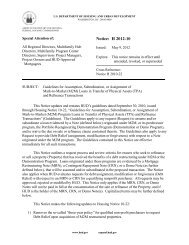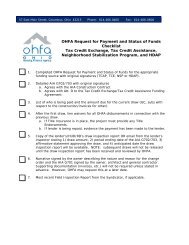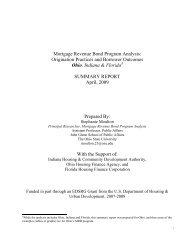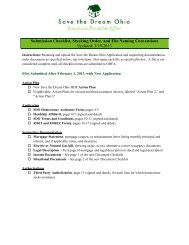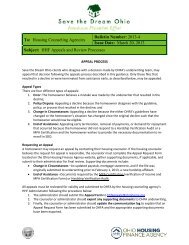lis 217 stemming the tide - LISC
lis 217 stemming the tide - LISC
lis 217 stemming the tide - LISC
- No tags were found...
Create successful ePaper yourself
Turn your PDF publications into a flip-book with our unique Google optimized e-Paper software.
Owner Assessments. Assessment of <strong>the</strong>owner's intentions and needs, and <strong>the</strong> capacityand interest of potential nonprofit purchasers.Legal Analysis. Analysis of potential legalclaims: notice requirements, existing userestrictions, HUD prepayment approval requirements,HUD-held or HUD-sold mortgage status,Enhanced Voucher legal requirements, and fairhousingissues. Minnesota law requires a oneyearnotice, including a Tenant ImpactStatement for all subsidized mortgage prepaymentsand subsidy contract opt-outs. 36 BecauseHUD-subsidized projects are disproportionatelyoccupied by minority residents, owners' actionsare often subject to fair-housing claims.Financial Analysis. Analysis of <strong>the</strong> feasibility ofretaining affordability under existing ownershiparrangements or through a sale to a nonprofitpurchaser. Each year, Minnesota appropriatesstate funds for preservation which are availablefor both existing owners and new purchasers.Publicity. Contacts with media, elected representatives,and government agencies focuspublic attention on <strong>the</strong> project.Resolution. Wherever possible, development ofa preservation-oriented alternative throughnegotiation. Litigation is a last resort, although<strong>the</strong> threat of litigation is often necessary andhelpful. In most cases, threatened litigation hasresulted in a favorable settlement.Case Study #1: Franklin Lane ApartmentsThis 66-unit project financed under Section 236is located in an integrated suburb outsideMinneapo<strong>lis</strong> and is occupied primarily by elderlyand disabled residents. Historically, <strong>the</strong>Section 236 rents have been substantiallybelow market. A few years ago, <strong>the</strong> owner soldto a private purchaser who intended to prepay<strong>the</strong> subsidized mortgage and convert <strong>the</strong> propertyto market-rate.StrategiesPreservation advocates and attorneys initiallypressured HUD to deny <strong>the</strong> Transfer of PhysicalAssets application, but this tactic failed. Withstrong political support from community groupsand local officials, tenants <strong>the</strong>n launched ayear-long media and advocacy campaign.Tenants threatened litigation based on fairhousingclaims and potential violations of federaland state notice laws, and prepared topicket <strong>the</strong> owner's new restaurants downtown.OutcomeThese actions brought <strong>the</strong> new owner to <strong>the</strong>negotiating table and ultimately resulted in <strong>the</strong>transfer of ownership to a community-basednonprofit purchaser. Resources for <strong>the</strong> transactionincluded federal Low Income Housing TaxCredits, state preservation funds, county HOMEfunds, retained IRP subsidy, and project-basedcertificates through <strong>the</strong> PHA for all of <strong>the</strong> units.No tenants were displaced and long-termaffordability was secured.Case Study #2: Hopkins VillageThis 161-unit Section 236 project located inano<strong>the</strong>r integrated suburb of Minneapo<strong>lis</strong> isoccupied primarily by elderly and disabled personsas well as some families of color. The projectis partially-assisted with a Section 8 LMSAcontract covering 64 units. The owner notified<strong>the</strong> tenants of his intention to prepay <strong>the</strong> mortgageand opt out.StrategiesInitial negotiations with HUD, <strong>the</strong> local housingfinance agency, and <strong>the</strong> tenants were unsuccessful.After <strong>the</strong> owner rejected <strong>the</strong> housingfinance agency's offer of state preservationfunds, as well as a purchase offer from a nonprofit,residents and advocates sued <strong>the</strong> ownerand HUD for failing to comply with fair-housingand federal and state notice laws. 37 The preservationcampaign received widespread publicityand community support.OutcomeAlmost immediately, HUD called a settlementconference, and <strong>the</strong> owner ultimately agreed tosell to a nonprofit. Resources for <strong>the</strong> transactionincluded federal Low Income Housing TaxCredits, state preservation funds, retained IRPsubsidy and project-based Section 8 subsidies.26 chapter three: State and Local Preservation Tools and Strategies



